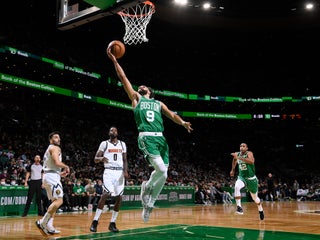Summary
Credit cards typically put a cap on high percentage rewards earnings but inflation is outpacing price changes, so perhaps they should raise limits periodically.
The content on this page is accurate as of the posting date; however, some of our partner offers may have expired. Please review our list of best credit cards, or use our CardMatch™ tool to find cards matched to your needs.
Inflation, of course, is running hot at the moment. The latest Consumer Price Index released by the U.S. Bureau of Labor Statistics showed a 5.4% year-over-year increase, matching the largest rise in 13 years. Food, shelter and energy are among the sectors experiencing the biggest spikes. This is making it harder for many Americans to meet their basic needs.
Check out all the answers from our credit card experts.
It’s also cutting into credit card rewards
Yes, I realize that inflation cutting into rewards is a first-world problem. But if you’re on this site, you’re probably a credit card enthusiast like me. And many of us like to earn cash back on everyday purchases to help lower our bills.
My favorite credit card is the Blue Cash Preferred® Card from American Express. I especially love the fact that it gives 6% cash back on U.S. supermarket purchases (up to $6,000 in annual purchases, then the rate drops to 1% cash back). If you spend exactly $6,000 at U.S. supermarkets in a year, you’ll earn $360 in cash back. That alone more than justifies the $95 annual fee.
I like some of the card’s other perks, too, but let’s stick with the grocery example. My family of four spends an average of about $240 per week (approximately $12,500 per year) on groceries. That’s why the $6,000 cap bugs me. And it hasn’t changed since it was introduced in 2012.
If it were adjusted for inflation, $6,000 in 2012 is equivalent to $7,169 today, according to USInflationCalculator.com. Shouldn’t the limit rise periodically to reflect price changes?
Unfortunately, credit card rewards caps rarely change
For example, the Chase Freedom Flex℠ and the Discover it® Cash Back card are two popular no-annual-fee cards that give 5% cash back on rotating categories that change every three months. Both require activation and limit the 5% rate to $1,500 in quarterly purchases, awarding 1% cash back beyond that. These cards haven’t raised their $1,500 caps since 2011 and 2012, respectively. Adjusted for inflation, $1,500 in 2011 is $1,829 today and $1,500 in 2012 equates to $1,792 at present.
Because these spending caps haven’t kept pace with inflation, it’s costing cardholders rewards. In other words, my grocery bills are going up, but my $6,000 limit on 6% cash back isn’t.
Since I spend approximately $12,500 per year on groceries, if I earn 6% cash back on the first $6,000 but just 1% on the remaining $6,500, I end up with $425 in rewards. After subtracting the annual fee, that’s $330. It’s still more than the $250 I’d get from a no-annual-fee 2% cash rewards card like the Wells Fargo Active Cash® Card, but the gap will continue to narrow if inflation continues to rise and the cap remains the same.
Possible solutions
Ideally, card issuers would raise these caps. It’s a competitive industry, so if one raised the bar there’s a good chance others would follow. I don’t think it’s a coincidence that a $6,000 annual cap represents the same amount of yearly spending as a $1,500 quarterly cap. And the Citi Custom Cash℠ Card gives 5% cash back on each cardholder’s top spending category each billing cycle (up to $500 in eligible purchases, then 1% cash back after that). Multiplying $500 by 12 months is – wait for it – $6,000 per year. There’s clearly something magical about that number.
I get it: These are businesses that want to make money. There’s certainly a hefty profit margin when someone pays the average credit card rate of 16.16% month after month. But when cardholders pay their bills in full and avoid interest, a high cash back payout is costing the bank money. Card issuers earn interchange revenue (paid by merchants) every time a customer uses the card, but this is typically something like 2% or 2.5%. And to be fair, while they haven’t raised their spending caps in a while, Amex, Chase and Discover have introduced other perks that have made the aforementioned cards more valuable.
Still, I think raising the caps would make sense, especially since it hasn’t been done in about a decade. It might even be necessary to keep rewards maximizers happy. If someone wants to maximize more spending than their card will allow, the most logical thing to do would be to get another card, which could push them to a competitor.
My personal take
While I could gain access to a second Blue Cash Preferred if my wife were to open one in her name, let’s say I don’t want to do that. Maybe I’d rather give the Citi Custom Cash a whirl (especially since it doesn’t charge an annual fee). If I timed my purchases correctly, that would roughly double the cash back I earn each year on groceries.
For now, I’ve actually backed into a lucrative split between the Blue Cash Preferred and the Freedom Flex. The Freedom Flex (which I got years ago when it was simply known as the Chase Freedom card) has included grocery stores as one of its quarterly 5% cash back categories for a long time. This year, I can essentially nab a second 5% cash back quarter via the card’s top spend bonus promotion running through Dec. 31, 2021.
That was a lucky (but seemingly temporary) break. I don’t know yet what I’ll do in 2022 and beyond. Between inflation and two growing kids, my grocery bills are climbing, so I want to maximize my return on that spending.
Have a question about credit cards? E-mail me at ted.rossman@creditcards.com and I’d be happy to help.
Editorial Disclaimer
The editorial content on this page is based solely on the objective assessment of our writers and is not driven by advertising dollars. It has not been provided or commissioned by the credit card issuers. However, we may receive compensation when you click on links to products from our partners.





